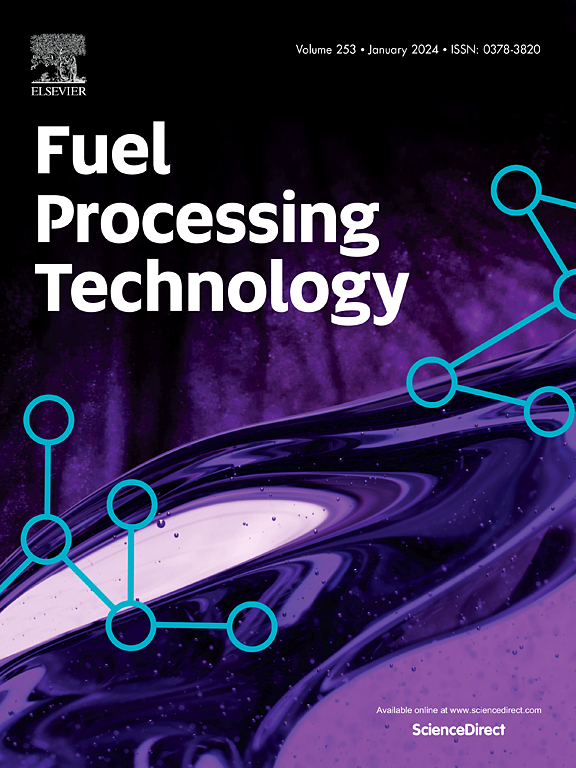Insight in the phenomena included in loss of the activation of industrial hydrotreating catalyst through an innovative accelerated deactivation procedure and kinetic modeling
IF 7.7
2区 工程技术
Q1 CHEMISTRY, APPLIED
引用次数: 0
Abstract
An innovative accelerated experimental procedure was developed to study the activity loss of a bifunctional gasoil hydrotreating (GHT) catalyst in a Bench-Scale fixed bed reactor system. This procedure aimed to estimate the impact of coke formation throughout the catalyst's lifespan, from fresh to fully deactivated. Experiments were conducted over 3500 h using a NiMo catalyst to measure the conversion decrease of sulfuric, nitrogenic, and aromatic compounds, indicating catalyst activity loss in hydrotreating reactions. The initial study examined how temperature, pressure, liquid hourly space velocity (LHSV), and hydrogen-to-hydrocarbon ratio affected catalyst deactivation. Results showed that hydrodenitrogenation (HDN) was most impacted by deactivation, while hydrodesulfurization (HDS) was affected to a lesser extent (about one-third of HDN), and hydrodearomatization (HDA) exhibited an intermediate effect. Thermo-Gravimetric Analysis (TGA) revealed that about 20 % of the coke on the deactivated catalyst consisted of volatile matter trapped in the pores. Approximately 60 % of the coke decomposed between 300 °C and 660 °C, while the remaining residue decomposed at higher temperatures. To identify key operating variables affecting catalyst activation loss, intrinsic and apparent kinetic models together with different deactivation functions were developed and fine-tuned. Statistical analysis confirmed that accumulated feed flow rate was the most significant factor in catalyst deactivation.

通过创新的加速失活程序和动力学建模,深入了解工业加氢处理催化剂失活现象
提出了一种创新的加速实验方法,用于研究双功能汽油加氢处理(GHT)催化剂在实验规模固定床反应器系统中的活性损失。这个程序的目的是估计焦炭形成的影响在整个催化剂的寿命,从新鲜到完全失活。在3500 h的加氢反应时间内,用镍基催化剂测定了硫、氮和芳香族化合物的转化率降低,表明加氢反应中催化剂的活性损失。最初的研究考察了温度、压力、液体时空速(LHSV)和氢烃比对催化剂失活的影响。结果表明,失活对氢脱氮(HDN)的影响最大,对氢脱硫(HDS)的影响较小(约为HDN的三分之一),对氢脱芳(HDA)的影响中等。热重分析(TGA)表明,失活催化剂上约20%的焦炭是由孔隙中的挥发性物质组成的。约60%的焦炭在300℃至660℃之间分解,其余残渣在更高温度下分解。为了确定影响催化剂活化损失的关键操作变量,建立了本征和表观动力学模型,并对不同失活函数进行了微调。统计分析证实,累积进料流量是催化剂失活的最重要因素。
本文章由计算机程序翻译,如有差异,请以英文原文为准。
求助全文
约1分钟内获得全文
求助全文
来源期刊

Fuel Processing Technology
工程技术-工程:化工
CiteScore
13.20
自引率
9.30%
发文量
398
审稿时长
26 days
期刊介绍:
Fuel Processing Technology (FPT) deals with the scientific and technological aspects of converting fossil and renewable resources to clean fuels, value-added chemicals, fuel-related advanced carbon materials and by-products. In addition to the traditional non-nuclear fossil fuels, biomass and wastes, papers on the integration of renewables such as solar and wind energy and energy storage into the fuel processing processes, as well as papers on the production and conversion of non-carbon-containing fuels such as hydrogen and ammonia, are also welcome. While chemical conversion is emphasized, papers on advanced physical conversion processes are also considered for publication in FPT. Papers on the fundamental aspects of fuel structure and properties will also be considered.
 求助内容:
求助内容: 应助结果提醒方式:
应助结果提醒方式:


